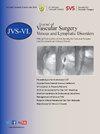电凝与射频热消融治疗静脉曲张的长期疗效比较。
IF 2.8
2区 医学
Q2 PERIPHERAL VASCULAR DISEASE
Journal of vascular surgery. Venous and lymphatic disorders
Pub Date : 2025-04-08
DOI:10.1016/j.jvsv.2025.102245
引用次数: 0
摘要
目的:热消融越来越多地被用作传统手术治疗原发性静脉曲张的替代方法。电凝消融(EA)大隐静脉(GSV)的有效性和安全性与射频消融(RFA)相当;然而,其长期结果以前没有调查过。方法:本研究采用双盲随机临床试验,对患者进行长期随访。下肢静脉曲张和GSV功能不全患者随机分为EA组和RFA组。随访时间分别为1周、3个月、6个月和每年一次。测量的主要结果是GSV阻塞,通过术后双工超声检查评估。次要结果包括并发症发生率和生活质量的改善,使用阿伯丁静脉曲张问卷评分进行评估。结果:共纳入57例患者,共涉及85例经治疗的GSVs;EA治疗42条静脉,RFA治疗43条静脉。在1周、3个月和6个月的随访中,两组在GSV闭塞率(分别为P = 0.430、P = 0.157和P = 0.157)、并发症发生率(分别为P = 0.717、P = 0.317和P = 0.320)和生活质量评分改善(分别为P = 0.540、P = 0.786和P = 0.401)方面均无统计学差异。中位随访时间为4.8年(95%可信区间为4.5-5.1年),获得59例手术(69.4%)的数据,显示EA组(n = 29)的闭塞率为89.7%,RFA组(n = 30)的闭塞率为66.7% (P = 0.001)。两组无手术相关并发症(P = .127),两组在阿伯丁静脉曲张问卷评分上无显著差异(P = .345)。结论:EA已经证明了GSV消融的有效性和安全性,与RFA相比,在长期随访中实现了更高的静脉闭塞率。此外,在长期随访中,两种方法的并发症发生率、对症状和生活质量的影响具有可比性。本文章由计算机程序翻译,如有差异,请以英文原文为准。
Long-term outcomes of electrocoagulation versus radiofrequency thermoablation for varicose veins
Objective
Thermoablation is increasingly being used as an alternative to traditional surgery for treating primary varicose veins. Electrocoagulation ablation (EA) of the great saphenous vein (GSV) has demonstrated effectiveness and safety comparable with that of radiofrequency ablation (RFA); however, its long-term outcomes have not been investigated previously.
Methods
This study involves a long-term follow-up of patients who participated in a double-blind, randomized clinical trial. Individuals with lower limb varicose veins and incompetence of GSV were randomly assigned to two treatment groups: EA and RFA. Follow-up assessments were scheduled at 1 week, 3 months, 6 months, and annually thereafter. The primary outcome measured was GSV occlusion, evaluated through postoperative duplex ultrasound examination. Secondary outcomes included the complication rate and improvements in quality of life, assessed using the Aberdeen Varicose Vein Questionnaire score.
Results
A total of 57 patients were included, which involved a cumulative 85 treated GSVs; 42 veins were treated with EA and 43 with RFA. At the 1-week, 3-month, and 6-month follow-ups, there were no statistically significant differences between the two groups regarding GSV occlusion rates (P = .430, P = .157, and P = .157, respectively), complication rates (P = .717, P = .317, and P = .320, respectively), or improvements in quality-of-life scores (P = .540, P = .786, and P = .401, respectively). After a median follow-up duration of 4.8 years (95% confidence interval, 4.5-5.1 years), data for 59 procedures (69.4%) were available, showing occlusion rates of 89.7% for the EA group (n = 29) and 66.7% for the RFA group (n = 30) (P = .001). There were no procedure-related complications (P = .127) and no significant differences in the Aberdeen Varicose Vein Questionnaire scores (P = .345) between the two groups analyzed.
Conclusions
EA has demonstrated effectiveness and safety for ablation of the GSV, achieving a higher rate of venous occlusion compared with RFA in the long-term follow-up. Additionally, the occurrence of complications and the impact on symptoms and quality of life were comparable between the two methods during long-term follow-up.
求助全文
通过发布文献求助,成功后即可免费获取论文全文。
去求助
来源期刊

Journal of vascular surgery. Venous and lymphatic disorders
SURGERYPERIPHERAL VASCULAR DISEASE&n-PERIPHERAL VASCULAR DISEASE
CiteScore
6.30
自引率
18.80%
发文量
328
审稿时长
71 days
期刊介绍:
Journal of Vascular Surgery: Venous and Lymphatic Disorders is one of a series of specialist journals launched by the Journal of Vascular Surgery. It aims to be the premier international Journal of medical, endovascular and surgical management of venous and lymphatic disorders. It publishes high quality clinical, research, case reports, techniques, and practice manuscripts related to all aspects of venous and lymphatic disorders, including malformations and wound care, with an emphasis on the practicing clinician. The journal seeks to provide novel and timely information to vascular surgeons, interventionalists, phlebologists, wound care specialists, and allied health professionals who treat patients presenting with vascular and lymphatic disorders. As the official publication of The Society for Vascular Surgery and the American Venous Forum, the Journal will publish, after peer review, selected papers presented at the annual meeting of these organizations and affiliated vascular societies, as well as original articles from members and non-members.
 求助内容:
求助内容: 应助结果提醒方式:
应助结果提醒方式:


